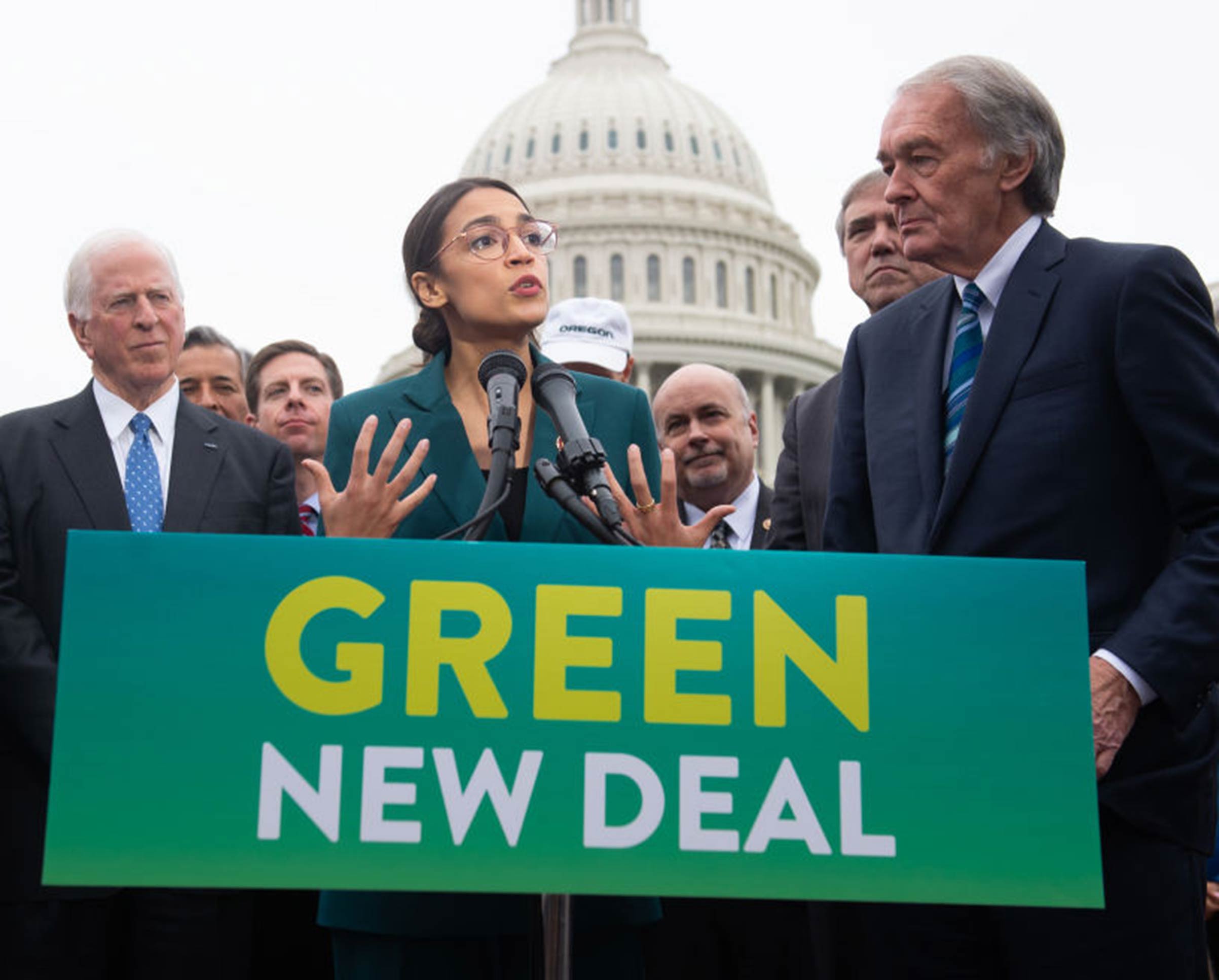by Huda Oskui
On February 7th, the representative for the 14th Congressional district of New York and a member of the Democratic Alexandria Ocasio Cortez introduced her Green New Deal in the House Of Representatives.
This legislation, which is a non-binding resolution, lays out a 10-year plan to combat climate change. Even though its main focus is to reduce emissions, it covers a broad number of issues. This legislation, named after Franklin D Roosevelt’s “New Deal–”which addressed issues to help overcome the Great Depression–has a number of goals which it hopes to accomplish in a decade. The main five goals focus on:
- Achieving net-zero greenhouse gas emissions by transitioning to renewable energy sources. Currently, renewable energy only accounts for 20% of the US energy production but this deal aims to meet 100% of the country’s power demand through clean, renewable energy.
- Creating millions of more high-wage jobs to help the country prosper both economically and socially. The deal also includes “strengthening and enforcing labor, workplace health and safety, anti-discrimination, and wage and hour standards across all employers, industries, and sectors”.
- Investing the infrastructure and industry of the United States to help meet the demands and changes of the 21st century. The plan outlines that its goals to invest in “(i)zero-emission vehicle infrastructure and manufacturing; (ii) clean, affordable, and accessible public transportation; and (iii) high-speed rail”
- Securing the country for years to come by having clean air and water, access to healthy food and a sustainable environment. This includes having high-quality healthcare for all as well as “adequate housing.”
- Promoting justice and equality for all, especially minorities such as indigenous people, migrants and people of color. This includes obtaining permission from indigenous groups when making decisions pertaining to them. An example of this would be the North Dakota Pipeline.
Even though the points above highlight the main goals of the Green New Deal, certain aspects of the deal have received much attention, such as the ones mentioned by President Trump. He tweeted, “I think it is very important for the Democrats to press forward with their Green New Deal. It would be great for the so-called “Carbon Footprint” to permanently eliminate all planes, cars, cows, oil, gas & the Military – even if no other country would do the same. Brilliant!”
Planes and Cars
The Green New Deal highlights one of its goals being a high-speed rail to reduce carbon emissions. This is due to the fact that 28% of the United States total emissions come from transportation and having a zero emission vehicle infrastructure– such as the high-speed rail that is proposed– would decrease this massively. Many critics of this deal, such as President Trump, believe that the Green New Deal would “permanently eliminate” cars and planes, which is not what the deal is proposing.
Cows
People who oppose the Green New Deal have come out and said that it will ban cows in America. If you think that this sounds deranged, that’s because it is. The deal does not want to “ban cows” or eliminate them in any way shape or form but instead aims to work “collaboratively with farmers and ranchers in the United States to eliminate pollution and greenhouse gas emissions from the agricultural sector as much as is technologically feasible.” This is an important issue to focus on since beef produces 41% of all the greenhouse gasses in the agricultural sector which as a whole is responsible for 14% of it.
Oil and Gas
The use of oil and gas to power the country is having a detrimental effect not only on the United States but on a larger global scale, too. According to the Environmental Protection Agency, generating electricity accounts for about 28 percent of the nation’s greenhouse gas emissions. Natural gas takes up about 32% of this and coal another 30%. Using renewable energy instead of nonrenewable energy such as oil and gas would not only be beneficial for the climate but would also be economically feasible in the years to come. Renewable resources and energy efficient technology such as smart grids will eventually help result in net-zero greenhouse gas emissions.
Military
Even though President Trump’s tweet mentions that the Green New Deal would eliminate the United States military, the deal fails to mention the military at all. President Trump’s claims came is a result of the Green New Deal being confused with the Green Party of the United States. The Green Party’s policy which is also called “Green New Deal” includes cutting military spending “at least by half” and closing military bases overseas, but still does not mention eliminating the military altogether.
But who will pay for all this?
The biggest reason why people are so skeptical of the Green New Deal is the fact that people believe that this would lead the United States into a state of debt and would lead to inflation. There are multiple ways to pay for the Green New Deal and one of them includes the massive tax cuts that are given to the top 10% of Americans each year. Last year $2 trillion were given to billionaires as tax returns. Alexandra Ocasio Cortez also proposed a 70% tax marginal income tax rate for people in the higher tax brackets. Many argue that this is very high, but there have been higher tax rates in the past. Under Eisenhower, the tax rate for the top earners was 91%. Many studies also suggest that Cortez’s suggested tax rate is pretty low.
Sources
https://www.cnn.com/2019/02/14/politics/green-new-deal-proposal-breakdown/index.html
https://www.congress.gov/bill/116th-congress/house-resolution/109/text
Featured image from Time
